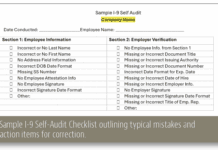Hold on folks; Federal OSHA is about to open your doors to outsiders during inspections! OSHA is proposing to amend its “Representatives of Employers and Employees” regulation to clarify that the representative(s) authorized by employees may be an employee of the employer or a third party; such third-party employee representative(s) may accompany OSHA when they are “reasonably necessary to aid in the inspection.” OSHA is also proposing clarifications of the relevant knowledge, skills or experience with hazards or conditions in the workplace or similar workplaces, or language skills of third-party representative(s) authorized by employees who may be reasonably necessary to the conduct of OSHA’s physical inspection of the workplace. OSHA has preliminarily determined that the proposed changes will aid OSHA’s workplace inspections by better enabling employees to select a representative of their choice to accompany OSHA during a physical workplace inspection.
Currently, federal regulations grant a representative of the employer and a representative authorized by employees the opportunity to accompany OSHA during the physical inspection of the workplace for the purpose of aiding the inspection. However, that representative must be an employee of said employer. If an employee wants an outside representative, that individual must have specific safety knowledge such as a safety engineer or industrial hygienist. OSHA is proposing to revise its regulations to clarify the types of individuals who can be a representative(s) authorized by employees during OSHA’s physical inspections of the workplace (also referred to as the “walk-around inspection”). In other words, they are going to “open it up” and expand it.
OSHA is proposing two revisions to its regulations. First, OSHA is proposing to clarify that the representative(s) authorized by employees may be an employee of the employer or a third party. Second, OSHA is proposing to clarify that a third-party representative authorized by employees may be reasonably necessary to the conduct of an effective and thorough physical inspection of the workplace by virtue of their knowledge, skills, or experience. This revision truly broadens the qualifications and no longer limits the third party to be the two examples provided in existing regulatory text: Industrial Hygienist or Safety Engineer.
Currently, when the representative(s) authorized by employees are not employed by the employer, they may accompany the OSHA inspector during the inspection if in the judgment of the inspector, good cause has been shown why they are reasonably necessary to the conduct of an effective and thorough physical inspection of the workplace. OSHA proposes to revise the regulations to clarify that third-party representatives authorized by employees may have a variety of skills, knowledge or experience that could aid the inspector’s inspection. This includes knowledge, skills or experience with hazards or conditions in the workplace or similar workplaces as well as any relevant language skills a representative may have to facilitate better communication between workers and the inspector. Therefore, OSHA proposes to delete the examples of industrial hygienists and safety engineers currently in the regulation so that the focus is on the knowledge, skills or experience of the individual rather than their professional discipline. This is where it goes south. OSHA goes as far as to suggest union leaders or agents as potential candidates for third party representatives. OSHA also highlights several scenarios where they believe a third-party representative may be necessary including multi-employer sites (i.e., farm labor contractors), situations when the employee may not be fluent in English and occasions where the employee may be experiencing cultural barriers or fearing retaliation from their employer.

OSHA invited stakeholders to comment on all aspects of this proposal. OSHA sought input on whether to maintain the existing requirement for a third-party employee representative to be “reasonably necessary to the conduct of an effective and thorough physical inspection of the workplace.”
Should OSHA defer to the employees’ selection of a representative to aid the inspection when the representative is a third party (i.e., remove the requirement for third-party representatives to be reasonably necessary to the inspection)? Why or why not?
Should OSHA retain the language as proposed, but add a presumption that a third-party representative authorized by employees is reasonably necessary to the conduct of an effective and thorough physical inspection of the workplace? Why or why not?
Should OSHA expand the criteria for an employees’ representative that is a third party to participate in the inspection to include circumstances when the inspector determines that such participation would aid employees in effectively exercising their rights under the OSH Act? Why or why not? If so, should OSHA defer to employees’ selection of a representative who would aid them in effectively exercising their rights?
OSHA opened this proposal for comments for 60 days ending in October. There is a lot of employer opposition as one might imagine, but with the current Federal Administration, who knows where this one ends up. If it passes, companies need to prepare for attempts at unionization. For us here in California, OSHA has preliminarily determined that, within six months of the promulgation of a final rule, State Plans would be required to adopt regulations that are identical or “at least as effective” as this rule unless they demonstrate that such amendments are not necessary because their existing requirements are already “at least as effective” in protecting workers as the Federal rule.












